
Ahoy! This is the Weekly Churn, where every Sunday I post about what I’ve been reading, watching, and thinking about over the previous week. This week I thought a lot about comic books. I swear most Weekly Churn posts aren’t going to be as long as this one.
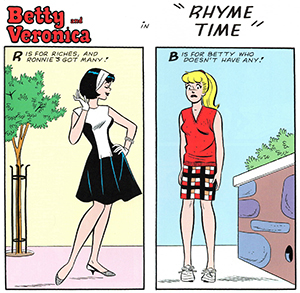 I’ve been a comics nerd for as long as I can remember. I don’t know what my first books were; likely some Garfield collections. I have a distinct memory of asking my father for one at Harley’s grocery store and him telling me that I could get colouring books cheaper somewhere else. I was an Archie fiend for years, first glomming on to Dan DeCarlo’s depictions of Betty and Veronica,[ref]I’ve always liked the girls best; they seem to be at the core of the book more than even Archie himself. If you’re as big a fan as I am I heartily recommend Twelve Cent Archie, Bart Beaty’s para-academic study of ’60s-era Archie comics.[/ref] and then slowly acknowledging that Harry Lucey’s work was superior, although there have been a number of other fine artists to work on Archie over the years. I can’t say I’ve ever been a fan of Dan Parent’s, however, and it seems a shame to me that his style has taken over from DeCarlo’s as the de facto house style. DeCarlo was a pinup specialist, making his work less fluid and comedically nuanced than Lucey’s, but Parent’s work strays too far into the iconographic side of the cartooning spectrum. His characters are over-simplified and rigid, looking like so many carefully-posed paper dolls that have more in common with South Park than with Bob Montana. Anyway, the number of Digests and Double Digests I managed to collect from grocery store spin-racks was truly absurd. Easily a few hundred. Somehow I also wound up with some issues from the Gary Kwapisz era of The Savage Sword of Conan.[ref]Your guess is as good as mine. I would have been five when issue #111 came out, the only one I remember clearly.[/ref] Around the age of twelve I started into superhero titles, just in time for many of the big name artists to bail on Marvel and DC to launch Image. Oddly enough, that was my first direct exposure to workers’ rights issues and collective action. I followed some of the Image books for a while, but I soon grew bored of superheroes—less with the idea of them than with their execution. Image books looked spectacular but were very poorly written, and with some exceptions, like the incomparable Chris Bachalo, the stable of artists left at the Big Two were either competent but out-of-fashion old-timers or raw youngsters who weren’t quite ready for the Big Show. The quality of their flagship titles slipped, and we got a lot of holograms and die-cuts and other nonsense to boost sales. The scene got awful in a hurry. I started reading stuff with less mainstream appeal instead. I probably bought half of what Vertigo was publishing in those days, and I was reading Cerebus, Bone, Sin City, Scud: The Disposable Assassin, even some Antarctic Press books and random self-published one-shots. If somebody was doing something weird and new with the medium, I wanted to read it.[ref]But not, like, ’60s counter-culture weird—for whatever reason I’ve never had much patience with trippy psychological navel-gazing that de-prioritizes craft. Poorly-drawn dream-journal comics were a hard pass, and they seemed to be everywhere in the indie scene then.[/ref]
I’ve been a comics nerd for as long as I can remember. I don’t know what my first books were; likely some Garfield collections. I have a distinct memory of asking my father for one at Harley’s grocery store and him telling me that I could get colouring books cheaper somewhere else. I was an Archie fiend for years, first glomming on to Dan DeCarlo’s depictions of Betty and Veronica,[ref]I’ve always liked the girls best; they seem to be at the core of the book more than even Archie himself. If you’re as big a fan as I am I heartily recommend Twelve Cent Archie, Bart Beaty’s para-academic study of ’60s-era Archie comics.[/ref] and then slowly acknowledging that Harry Lucey’s work was superior, although there have been a number of other fine artists to work on Archie over the years. I can’t say I’ve ever been a fan of Dan Parent’s, however, and it seems a shame to me that his style has taken over from DeCarlo’s as the de facto house style. DeCarlo was a pinup specialist, making his work less fluid and comedically nuanced than Lucey’s, but Parent’s work strays too far into the iconographic side of the cartooning spectrum. His characters are over-simplified and rigid, looking like so many carefully-posed paper dolls that have more in common with South Park than with Bob Montana. Anyway, the number of Digests and Double Digests I managed to collect from grocery store spin-racks was truly absurd. Easily a few hundred. Somehow I also wound up with some issues from the Gary Kwapisz era of The Savage Sword of Conan.[ref]Your guess is as good as mine. I would have been five when issue #111 came out, the only one I remember clearly.[/ref] Around the age of twelve I started into superhero titles, just in time for many of the big name artists to bail on Marvel and DC to launch Image. Oddly enough, that was my first direct exposure to workers’ rights issues and collective action. I followed some of the Image books for a while, but I soon grew bored of superheroes—less with the idea of them than with their execution. Image books looked spectacular but were very poorly written, and with some exceptions, like the incomparable Chris Bachalo, the stable of artists left at the Big Two were either competent but out-of-fashion old-timers or raw youngsters who weren’t quite ready for the Big Show. The quality of their flagship titles slipped, and we got a lot of holograms and die-cuts and other nonsense to boost sales. The scene got awful in a hurry. I started reading stuff with less mainstream appeal instead. I probably bought half of what Vertigo was publishing in those days, and I was reading Cerebus, Bone, Sin City, Scud: The Disposable Assassin, even some Antarctic Press books and random self-published one-shots. If somebody was doing something weird and new with the medium, I wanted to read it.[ref]But not, like, ’60s counter-culture weird—for whatever reason I’ve never had much patience with trippy psychological navel-gazing that de-prioritizes craft. Poorly-drawn dream-journal comics were a hard pass, and they seemed to be everywhere in the indie scene then.[/ref]
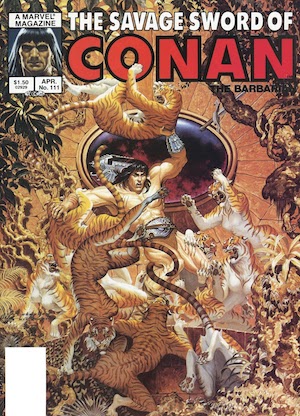
Bringing all these comics home created some strife in my house. It wasn’t really a space issue, although it could easily have become one. And it wasn’t financial: I was working a lot of hours at my after school jobs and I paid for any comics I bought with money I’d earned myself. My mother wasn’t much concerned with what I read; as long as I didn’t bring any L. Ron Hubbard into the house[ref]That truly was the only rule around reading material. My mother had a bad run in with Scientology when she was young and vulnerable and didn’t want anything associated with them in the house.[/ref] I was free to read anything that wasn’t outright pornography. At my father’s house things were different. He wasn’t especially censorious, but he definitely belonged to the Frederic Wertham school of comic book criticism, which is to say he thought they were a waste of time and morally corrupting, as well.[ref]My dad would have been twelve when Seduction of the Innocent was published.[/ref] My father had a habit of taking a given comic from my collection (or even grabbing one I was reading right from my hands), reading one or two pages without context, declaring it “garbage,” and then having an argument with me about my right to read them at all.
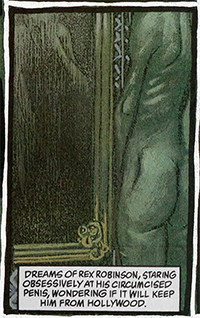 I remember one instance particularly well: I was sixteen, and the Sandman Midnight Theatre one-shot had just come out. It’s a collaboration between Neil Gaiman, Matt Wagner, and artist Teddy Kristiansen in which the two “Sandman” characters in the Vertigo books meet each other.[ref]One of the characters is a film-noir-style vigilante and the other is the anthropomorphic personification of a metaphysical concept.[/ref] The story takes place in England in the 1930s. My father took offence at one panel in particular, wherein a Jewish actor looks at himself, nude, in the mirror while getting ready for bed. It’s part of another character’s dream sequence. The actor’s name is Rex Robinson, but he was born Moishe Teitlebaum, and though it’s not a secret that he is Jewish, neither is it well known. His genitals are not shown, but the narration indicates that Rex is obsessed with the thought that “his circumcised penis” will keep him from having a career in Hollywood.[ref]Regular readers of the Sandman books will be aware that significant personal truths are revealed in dreams, even if in they are revealed in a different character’s dream.[/ref] My father saw this panel as being inherently pornographic, scandalous in general, and completely inappropriate for a comic book of any sort. The context for that panel isn’t even remotely pornographic or even sexual, and is quite distressing for other reasons. That the German film industry in the 1930s was a propaganda machine is well known, but less well known is Hollywood’s collaboration with Nazi Germany during that era for the purposes of suppressing films that criticized the Nazis and censoring Jewish characters, creators, and voices. Earlier in the comic, Rex Robinson was at a party where Nazi officials were rubbing shoulders with English power brokers and were attempting to hire Robinson to help them commit those acts of erasure. In the panel that upset my father, Robinson’s penis was intended as a synecdoche for his Jewishness, and he was in fact reflecting on how not only had he been experiencing direct, personal fear in the presence of so many Nazis and their collaborators, but also on how systemic anti-semitism had the potential to destroy his livelihood. It was a moment of intense helplessness and psychological vulnerability. Robinson was made physically vulnerable through his nudity and contemplation of his body in that panel in order to mirror his psychological state. I don’t think there’s any question that this is appropriate subject matter for art, but because the medium was comics my father couldn’t see it as art at all. There was a constant struggle in my father’s house over the legitimacy of comic books as reading material.
I remember one instance particularly well: I was sixteen, and the Sandman Midnight Theatre one-shot had just come out. It’s a collaboration between Neil Gaiman, Matt Wagner, and artist Teddy Kristiansen in which the two “Sandman” characters in the Vertigo books meet each other.[ref]One of the characters is a film-noir-style vigilante and the other is the anthropomorphic personification of a metaphysical concept.[/ref] The story takes place in England in the 1930s. My father took offence at one panel in particular, wherein a Jewish actor looks at himself, nude, in the mirror while getting ready for bed. It’s part of another character’s dream sequence. The actor’s name is Rex Robinson, but he was born Moishe Teitlebaum, and though it’s not a secret that he is Jewish, neither is it well known. His genitals are not shown, but the narration indicates that Rex is obsessed with the thought that “his circumcised penis” will keep him from having a career in Hollywood.[ref]Regular readers of the Sandman books will be aware that significant personal truths are revealed in dreams, even if in they are revealed in a different character’s dream.[/ref] My father saw this panel as being inherently pornographic, scandalous in general, and completely inappropriate for a comic book of any sort. The context for that panel isn’t even remotely pornographic or even sexual, and is quite distressing for other reasons. That the German film industry in the 1930s was a propaganda machine is well known, but less well known is Hollywood’s collaboration with Nazi Germany during that era for the purposes of suppressing films that criticized the Nazis and censoring Jewish characters, creators, and voices. Earlier in the comic, Rex Robinson was at a party where Nazi officials were rubbing shoulders with English power brokers and were attempting to hire Robinson to help them commit those acts of erasure. In the panel that upset my father, Robinson’s penis was intended as a synecdoche for his Jewishness, and he was in fact reflecting on how not only had he been experiencing direct, personal fear in the presence of so many Nazis and their collaborators, but also on how systemic anti-semitism had the potential to destroy his livelihood. It was a moment of intense helplessness and psychological vulnerability. Robinson was made physically vulnerable through his nudity and contemplation of his body in that panel in order to mirror his psychological state. I don’t think there’s any question that this is appropriate subject matter for art, but because the medium was comics my father couldn’t see it as art at all. There was a constant struggle in my father’s house over the legitimacy of comic books as reading material.
All this is to say that it’s strange I forgot to mention in last week’s post that on Sunday J and I went to see Jaime Hernandez in conversation with Jane van Koeverden at The Beguiling. I actually haven’t read much of Love and Rockets, though J is a huge fan. I tried once, impressed by Hernandez’ excellent art and intrigued by the slice-of-life nature of the Locas stories, but I couldn’t get past the science fiction elements and the weird density of the initial issues.[ref]Strange, I know.[/ref] I’m not the sort of person who can skip ahead in a series, or start a television show from the second season. I start at the beginning or I don’t start. I’ll come back to it again eventually, but for right now I’m someone who mostly knows L&R from Jaime Hernandez’s crisp art style.
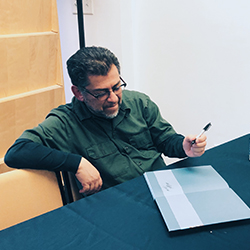 Hernandez didn’t have much to say about his process in the interview; he presented as the sort of artist who prefers a very organic way of working, which is fair enough. Something that J pointed out to me was that several times he seemed to want to open up about his dislike of how a global monoculture, or at least a global aesthetic, seems to be pushing out local art and entertainment. He expressed his joy in walking into comic book stores while he was travelling and seeing shelves full of locally-made mini-comics, and how special that was. He also spoke about his distance from wrestling culture. When he was a bigger fan—and I remember many of the characters he spoke about—he enjoyed how each region had its own local scene with its own local characters, and about how the wrestlers injected not just a sense of theatricality into their work, but also a sense of humour. They weren’t pulling one over on you, they were inviting you in on the joke. They wanted you to have fun. As J said, Hernandez seemed to be making a point—and given the nature of his work this makes sense—that what we’re losing in the face of these larger than life, world-spanning stories is our sense of the specific and the local, the importance of our stories being about us. (He also lamented that he doesn’t see as much focus on craft in the indie scene as he used to.) It was a good, if not particularly deep, interview, and Hernandez projected a real “I don’t really like the spotlight and I’m just happy to be here with all you lovely people” sort of vibe, which was reflected back at him by the crowd. Even the questions from the audience were actually questions. Even when the dudes asked them. J got her book signed and Hernandez just seemed like a chill, friendly guy. It was a good time.
Hernandez didn’t have much to say about his process in the interview; he presented as the sort of artist who prefers a very organic way of working, which is fair enough. Something that J pointed out to me was that several times he seemed to want to open up about his dislike of how a global monoculture, or at least a global aesthetic, seems to be pushing out local art and entertainment. He expressed his joy in walking into comic book stores while he was travelling and seeing shelves full of locally-made mini-comics, and how special that was. He also spoke about his distance from wrestling culture. When he was a bigger fan—and I remember many of the characters he spoke about—he enjoyed how each region had its own local scene with its own local characters, and about how the wrestlers injected not just a sense of theatricality into their work, but also a sense of humour. They weren’t pulling one over on you, they were inviting you in on the joke. They wanted you to have fun. As J said, Hernandez seemed to be making a point—and given the nature of his work this makes sense—that what we’re losing in the face of these larger than life, world-spanning stories is our sense of the specific and the local, the importance of our stories being about us. (He also lamented that he doesn’t see as much focus on craft in the indie scene as he used to.) It was a good, if not particularly deep, interview, and Hernandez projected a real “I don’t really like the spotlight and I’m just happy to be here with all you lovely people” sort of vibe, which was reflected back at him by the crowd. Even the questions from the audience were actually questions. Even when the dudes asked them. J got her book signed and Hernandez just seemed like a chill, friendly guy. It was a good time.
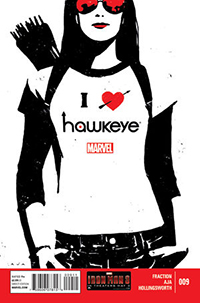 These days I’m mostly reading superhero comics again, with a handful of exceptions. I think there are some things happening in that space that have captured the sense of light-hearted fun comics can create, while still taking the characters and the readers seriously. Titles that come immediately to mind are Hawkeye (both Kate Bishop and Original Flavour), Jessica Jones, Ms. Marvel, Spider-Gwen, Batgirl (starting with Cameron Stewart’s run), Saga, Sex Criminals, and… Archie. Some of these books are doing interesting things with how you can structure a story visually, like with pictographs and colour cues, and some are breathing life into old genres with nuanced character work and the active subversion or avoidance of tropes, while others are just interesting new takes on classic characters. Archie in particular has something special going on with what Mark Waid and Fiona Staples have done to make the characters real and stable while still being recognizable to anyone who knows them from single-page gags in Pep.[ref]Staples is no longer on the book, but the series has brought in a fairly decent array of artists to follow her.[/ref] What all the titles have in common is that they haven’t lost sight of how much fun the medium can be when they aren’t afraid to let new people through the door to try new things.
These days I’m mostly reading superhero comics again, with a handful of exceptions. I think there are some things happening in that space that have captured the sense of light-hearted fun comics can create, while still taking the characters and the readers seriously. Titles that come immediately to mind are Hawkeye (both Kate Bishop and Original Flavour), Jessica Jones, Ms. Marvel, Spider-Gwen, Batgirl (starting with Cameron Stewart’s run), Saga, Sex Criminals, and… Archie. Some of these books are doing interesting things with how you can structure a story visually, like with pictographs and colour cues, and some are breathing life into old genres with nuanced character work and the active subversion or avoidance of tropes, while others are just interesting new takes on classic characters. Archie in particular has something special going on with what Mark Waid and Fiona Staples have done to make the characters real and stable while still being recognizable to anyone who knows them from single-page gags in Pep.[ref]Staples is no longer on the book, but the series has brought in a fairly decent array of artists to follow her.[/ref] What all the titles have in common is that they haven’t lost sight of how much fun the medium can be when they aren’t afraid to let new people through the door to try new things.
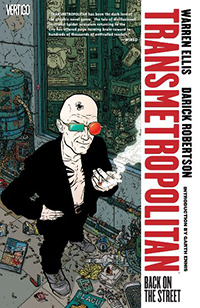 I also finally started on a classic Vertigo title that I never got into when it was first released: Transmetropolitan. There are things about it like. It has an intense, infectious energy and the density of its cyberpunk setting got me hooked after I found the first trade paperback on a friend’s shelf when I was visiting his family over the Christmas holiday break. The things that would have appealed to me as a teenager are the things I like least about it now. The book absolutely seethes with anger at just about everything, and often for reasons that aren’t clear; anger for the sake of anger. What Spider Jerusalem does isn’t journalism, and his screeds are, as often as not, either too vague to feel meaningful or simply hypocritical. There are so many conversations to be had around anger, and men’s anger in particular. Is expressing it the first step to understanding and dealing with it, or is it a way to avoid that? Is it foundational to righteous action or a smokescreen, a way of pretending on has acted rightly when one has not? Does it arise from understanding the world and one’s changing place in it, or from failing to understand it, or both? Is it inherently dangerous regardless of the answers to any of those other questions? Transmetropolitan, at least midway through volume three, doesn’t seem interested in addressing many of these questions, and is mostly dismissive of the ones it does address. Spider’s anger being the cornerstone his personality and his column being an outlet for that anger is the kind of tired bullshit that would have made me feel seen as a teenager but that just makes me roll my eyes now. Clearly intended as the centrepiece of the series, twenty years on Spider’s column seems like the weakest, least interesting thing in it.
I also finally started on a classic Vertigo title that I never got into when it was first released: Transmetropolitan. There are things about it like. It has an intense, infectious energy and the density of its cyberpunk setting got me hooked after I found the first trade paperback on a friend’s shelf when I was visiting his family over the Christmas holiday break. The things that would have appealed to me as a teenager are the things I like least about it now. The book absolutely seethes with anger at just about everything, and often for reasons that aren’t clear; anger for the sake of anger. What Spider Jerusalem does isn’t journalism, and his screeds are, as often as not, either too vague to feel meaningful or simply hypocritical. There are so many conversations to be had around anger, and men’s anger in particular. Is expressing it the first step to understanding and dealing with it, or is it a way to avoid that? Is it foundational to righteous action or a smokescreen, a way of pretending on has acted rightly when one has not? Does it arise from understanding the world and one’s changing place in it, or from failing to understand it, or both? Is it inherently dangerous regardless of the answers to any of those other questions? Transmetropolitan, at least midway through volume three, doesn’t seem interested in addressing many of these questions, and is mostly dismissive of the ones it does address. Spider’s anger being the cornerstone his personality and his column being an outlet for that anger is the kind of tired bullshit that would have made me feel seen as a teenager but that just makes me roll my eyes now. Clearly intended as the centrepiece of the series, twenty years on Spider’s column seems like the weakest, least interesting thing in it.
Toronto Comicon was this weekend! I don’t typically go for the whole thing, and this time was no exception—I only attended for a few hours on Friday evening. I love Artist’s Alley and the booths set up by small vendors and creators. I get to see the work of big names alongside people who are just starting out, or who have idiosyncratic styles that are never going connect with a wide audience but who still love to create and who still manage to reach people. That part is fun. I also usually go with my close friend Warren, and that’s always a good time, too. He’s there to buy and sell and trade, and I’ll pick up some things if I find something that catches my eye, but mostly I go to hang out. Which brings me to the vendor floor.
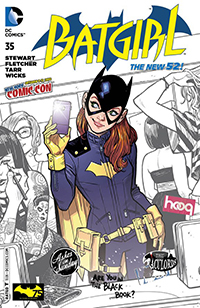 If I look at the vendor floor through the eyes of twelve-year-old me, it’s a fantastic place. A wonderland of cool stuff celebrating and engaged with all the comics and television and movies and so on that I love. There are cool toys, lots of art for your wall, costumes to wear, etc. I’m not even immune that now; I definitely own some collectables and have a deeply nostalgic relationship with some cheap, disposable stuff. But then forty-year-old me looks at it[ref]Yeah, I turn forty in a few months.[/ref] and, even in light of my own stuff, the vendor floor is suddenly the saddest, most sickening thing on earth. Booth after booth after booth of toys that were never meant to be played with, books that were never meant to be read. All the materials and labour to bring all that stuff to one place, and for what? Collectables and trinkets, key rings, statuettes, models, trading cards, little bits of plastic whatever that I couldn’t even identify, almost none of it able to be recycled and almost none of it having any purpose other than being locked in a plastic case until somebody on a website decides it’s worth more than it was the day it was bought, and then it gets hauled out and sold again. Rinse and repeat. It’s all very 1994. And this is before we even get to wall after wall of Japanese fuck pillows and mousepads with tits.[ref]You heard me.[/ref] There was one booth with a little monitor, and on it was a video of what appeared to be instructions on how to make your own busty mousepad at home. If that’s the place where we’ve landed then for God’s sake just the burn the fucker down and have done.
If I look at the vendor floor through the eyes of twelve-year-old me, it’s a fantastic place. A wonderland of cool stuff celebrating and engaged with all the comics and television and movies and so on that I love. There are cool toys, lots of art for your wall, costumes to wear, etc. I’m not even immune that now; I definitely own some collectables and have a deeply nostalgic relationship with some cheap, disposable stuff. But then forty-year-old me looks at it[ref]Yeah, I turn forty in a few months.[/ref] and, even in light of my own stuff, the vendor floor is suddenly the saddest, most sickening thing on earth. Booth after booth after booth of toys that were never meant to be played with, books that were never meant to be read. All the materials and labour to bring all that stuff to one place, and for what? Collectables and trinkets, key rings, statuettes, models, trading cards, little bits of plastic whatever that I couldn’t even identify, almost none of it able to be recycled and almost none of it having any purpose other than being locked in a plastic case until somebody on a website decides it’s worth more than it was the day it was bought, and then it gets hauled out and sold again. Rinse and repeat. It’s all very 1994. And this is before we even get to wall after wall of Japanese fuck pillows and mousepads with tits.[ref]You heard me.[/ref] There was one booth with a little monitor, and on it was a video of what appeared to be instructions on how to make your own busty mousepad at home. If that’s the place where we’ve landed then for God’s sake just the burn the fucker down and have done.
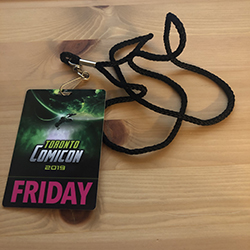 I’m even frustrated by the day pass I had to buy. Not the cost or anything, the actual physical object. Every other convention I’ve been to, and I’ve been to a few now, has given me a paper wristband to wear. The things aren’t super comfortable, and they’re a pain in the ass to take off, but you get used to them. You can also dump them in the blue box when you get home. Not this time! For this convention I got this enormous plastic card with an RFID tag embedded in it. Congratulations, because of the embedded electronics this can’t be recycled here, and neither can the lanyard, which appears to be made of some kind of black plastic fibre.[ref]Black plastics are not recyclable in many (most) jurisdictions because of how difficult they are to sort during processing.[/ref] I don’t know if conventions make any sort of explicit environmental commitments, and I can certainly see the usefulness of this style of pass, but Jesus fuck, what a waste.
I’m even frustrated by the day pass I had to buy. Not the cost or anything, the actual physical object. Every other convention I’ve been to, and I’ve been to a few now, has given me a paper wristband to wear. The things aren’t super comfortable, and they’re a pain in the ass to take off, but you get used to them. You can also dump them in the blue box when you get home. Not this time! For this convention I got this enormous plastic card with an RFID tag embedded in it. Congratulations, because of the embedded electronics this can’t be recycled here, and neither can the lanyard, which appears to be made of some kind of black plastic fibre.[ref]Black plastics are not recyclable in many (most) jurisdictions because of how difficult they are to sort during processing.[/ref] I don’t know if conventions make any sort of explicit environmental commitments, and I can certainly see the usefulness of this style of pass, but Jesus fuck, what a waste.
Which is not to say I didn’t have a good time. I came home with the latest issues of Ghost Cats, the newest RAID anthology, and the first volume of Legend of the Sunset People, by my friend Shawn Richison. Better than that, though, I got to spend some time talking with my friend Shawn, who I don’t get to see very often.
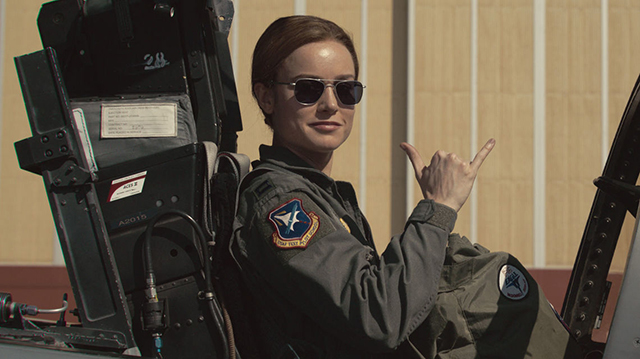
Saturday night was Captain Marvel at the IMAX theatre, and I had a good time. I’m looking forward to Carol Danvers showing up elsewhere in the MCU. The cat stole the movie, as everyone said it would, and Samuel L. Jackson seemed to be having a lot of fun. It’s good when actors look like they’re enjoying themselves. The film was funny, it had inspiring moments, it had a more interesting villain that just a horde of random whatever creatures you’ve never seen before and won’t ever see again.[ref]There isn’t really a clear, black-and-white villain in Marvel’s Kree-Skrull wars, and this film reflects that.[/ref] All the ingredients were there to make this as satisfying as Thor: Ragnarok, but it didn’t quite make it over the top. I think the biggest barrier was that they didn’t give Brie Larson enough to do. Here’s the deal: Brie Larson can act, and she has a fair bit of range. Controversies aside, they don’t generally give out Oscars for no reason. Jude Law’s character[ref]Who I’m sure had a name that wasn’t “Jude Law,” but I don’t care.[/ref] was constantly yelling at her to control her emotions, and that’s certainly intended as a reflection of the kind of gendered discrimination women face, since in those scenes Danvers was showing a pretty reasonable level of frustration and was not in any sense over emotional. Thematically that works. But the problem for the film was that Larson the actor wasn’t given enough opportunities to emote. When she was having an intimate conversation, cracking a joke, or doing anything other than just standing there staring at something or listening to another character monologue, she just came so fully to life that it raised the level of the entire film. She didn’t quite reach Robert Downey Jr. levels of charisma,[ref]That “getting up” montage, though. RDJ never got anything like that.[/ref] but she was easily a Mark Ruffalo or one of the Chrises, and the potential for her to be more and do more is clear.[ref]And in terms screen-time-to-emoting-opportunities ratio, her co-stars Ben Mendelsohn, Lashana Lynch, and of course Samuel L. Jackson did a whole lot of excellent work.[/ref] But she spent so much time in the film just kind of staring at things and waiting for people to finish talking, and it felt very flat in those moments. Again, that’s thematically appropriate, but it doesn’t quite land as deliberate, so I tend to think it’s more likely a directing problem rather than an acting problem. I buy Larson as a fighter pilot. I buy Larson as the cool aunt to a precocious kid. I buy Larson as a badass superhero, and as a best friend. I don’t buy Larson as much of anything at all when they make her stand around looking at nothing, and there was too much of that. It’s possible I’m mis-remembering the extent of these flat moments, but I absolutely recall thinking “this movie is kind of okay” several times, and then seeing Larson respond with some clear, strong emotion and immediately thinking “oh wow, this just got so much better, I wish there was more of this.” Anyway, Captain Marvel made a lot of money and it was fun, but it could have been much stronger if they’d given their fantastic lead actor more to work with.
That’s all for this week, folks. Thanks for reading!